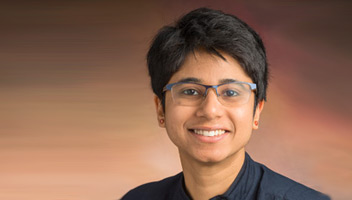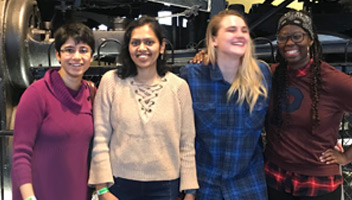HOW CAN WE HELP YOU? Call 1-800-TRY-CHOP
In This Section
Faculty Spotlight: “Follow the Questions” With Shaon Sengupta, MBBS, MPH

Shaon Sengupta, MBBS, MPH, attending neonatologist and faculty investigator.
Editor’s Note: This Q&A is the second in a series of monthly Cornerstone stories in which we sit down with faculty members at Children’s Hospital of Philadelphia Research Institute to learn more about their research and roles. Through these spotlights, our readers have the opportunity to meet the diverse, dedicated, and distinctive individuals who lead our research community in our mission to improve children’s health. In this Q&A, we feature Shaon Sengupta, MBBS, MPH, an attending neonatologist at Children’s Hospital of Philadelphia who has followed questions about circadian biology throughout her research career. Stay tuned for more from our Faculty Spotlight series throughout this year!
How long have you been at CHOP?
It’s been close to 10 years; I came to CHOP in 2011 as a fellow in Neonatology, and I’ve been on faculty since 2018.
Can you tell us a little bit about your research specialty?
My research program aims to uncover the circadian regulatory processes in lung injury that shape host response. In particular, we use an influenza model. Since my clinical specialty is neonatology, I’m now trying to understand if there is away for us to harness the power of circadian biology in neonatology. We know that the circadian rhythms of the sleep/wake cycle are not present at birth but they evolve over the period of the first few months. In the neonatal intensive care unit (NICU), we try our best, but even our most sophisticated treatment regimen has untoward consequences for the most fragile of patients. So, what happens if you expose the neonate at that very vulnerable time to many different adverse stimuli? Does it change the course of their circadian network and does that in turn account for some of the future consequences that are apparent long after the neonatal period? Those are the two main themes of my research program.
Could you explain circadian biology in your own words?
Circadian biology is a unique mechanism through which organisms can anticipate and prepare for changes in their environment in a manner that aids their survival. It is a complex and elegant process of nature that has evolved with life on the planet – it exists in very primitive organisms like cyanobacteria, and it’s the same basic mechanism that exists in us and all species in between. So, that really speaks to how important that process is.
Physicians have known about circadian biology, that sense of fluctuations across time of day, for a while; we know that we are not a static entity overall. For example, we say this medication is best taken at bedtime or these symptoms are worse at a particular time of day, etc. But circadian biology has only been studied at the molecular level in the last 30 years or so and that has really opened up the field. Before that, we knew very little about how it actually happens at a molecular level.
Why did you choose to study circadian biology?
I started out doing clinical research, and I trained in epidemiology and biostats before residency. That’s what I was going to do in my academic life along with my clinical neonatology practice. But I realized while doing one of those projects, published in JAMA Pediatrics, that you cannot answer the “why’s” and “how’s” of any process in entirety by doing clinical research alone. Figuring out how things work and why was really important to me as a researcher. So, I changed tracks from clinical epidemiology to more lab based research.
With that in mind, I joined the lab group of one of the previous faculty members at CHOP, Dr. Phyllis Dennery. She was the chief of Neonatology for over 10 years and is now the chair of Pediatrics at Brown University. Her research interest is in neonatal lung injury, in which she looked at different mechanisms through which neonatal lung injury happens and propagates — particularly in the context of neonatal hyperoxia. In the process, we stumbled across some circadian genes. And the more I heard about and read about the circadian network, the more pervasive it seemed and I was absolutely captivated by its potential.
I met with Dr. Amita Sehgal at the University of Pennsylvania and I think my conversion to circadian biology was complete. Shortly after that, Dr. Dennery was leaving for Brown University and that provided me a timely launchpad for my circadian interests. I had heard and met with Dr. Garet FitzGerald at Penn before and was really in awe of his work. I joined his group for the second part of my postdoctoral work. Since then I have procured my K08 and joined faculty in 2018.

Dr. Sengupta and her lab members at the Franklin Institute Science Museum (photo taken prior to COVID-19 pandemic).
Can you share any words of advice for young scientists or students who aspire to be physician scientists like yourself?
I still feel that I am more at the stage of receiving advice than giving it, but I will give it a shot. There are two things that have definitely worked for me. My path wasn't particularly straight and I doubt it is for anyone. There were definitely times when the majority public opinion was biased against the direction I was choosing. It was a bit unnerving and I was worried that I would be forced to change tracks or research questions because it seemed too uphill. But during some such point, I realized that it's never over until you say so. Grants will come and go, and results can be far from your original hypotheses. None of this external stuff matters if you don't give up. I am very appreciative of the fact the CHOP leadership has been incredibly supportive through all this and that has allowed to me reach this stage.
Second, at least this is my take home: follow the questions and let that guide your path. I did not think that I would be doing this kind of science when I was starting out as a fellow or as a pediatric resident for sure. But I find it very gratifying to be able to follow the questions as they presented themselves in the course of my work. If you let the questions guide you, you will always find a path forward to figure out the next steps. It’s much more fun that way. And that’s really why we are here as scientists: to let the question guide you rather than having very strict ideas of how things should go. At least that’s something that I always look back to, and it’s always served me well.
--Learn more about Dr. Sengupta’s research at February’s Faculty Luncheon, Feb. 18.